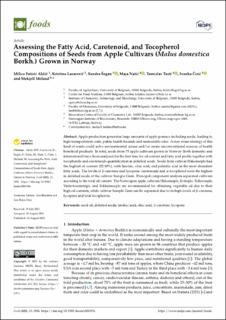Assessing the fatty acid, carotenoid, and tocopherol compositions of seeds from apple cultivars (Malus domestica borkh.) grown in norway
| dc.contributor.author | Aksic, Milica Fotiric | |
| dc.contributor.author | Lazarević, Kristina | |
| dc.contributor.author | Šegan, Sandra | |
| dc.contributor.author | Natić, Maja | |
| dc.contributor.author | Tosti, Tomislav | |
| dc.contributor.author | Ćirić, Ivanka | |
| dc.contributor.author | Meland, Mekjell | |
| dc.date.accessioned | 2022-01-28T10:38:34Z | |
| dc.date.available | 2022-01-28T10:38:34Z | |
| dc.date.created | 2021-11-28T18:47:12Z | |
| dc.date.issued | 2021-08-22 | |
| dc.identifier.citation | Foods. 2021, 10 (8), . | en_US |
| dc.identifier.issn | 2304-8158 | |
| dc.identifier.uri | https://hdl.handle.net/11250/2933755 | |
| dc.description.abstract | Apple production generates large amounts of apple pomace including seeds, leading to high transportation costs, public health hazards and undesirable odor. A new reuse strategy of this kind of waste could solve environmental issues and/or create unconventional sources of health beneficial products. In total, seeds from 75 apple cultivars grown in Norway (both domestic and international) have been analyzed for the first time for oil content and fatty acid profile together with tocopherols and carotenoids quantification in defatted seeds. Seeds from cultivar Håkonseple had the highest oil content (22.10%), with linoleic, oleic acid, and palmitic acid as the most abundant fatty acids. The levels of β-carotene and lycopene carotenoids and α-tocopherol were the highest in defatted seeds of the cultivar Sureple Grøn. Principal component analysis separated cultivars according to the total oil content. The Norwegian apple cultivars Håkonseple, Kviteple, Tolleivseple, Vinterrosenstrips, and Tokheimseple are recommended for obtaining vegetable oil due to their high oil contents, while cultivar Sureple Grøn can be separated due to its high levels of β-carotene, lycopene and total tocopherols. | en_US |
| dc.language.iso | eng | en_US |
| dc.publisher | MDPI, Basel, Switzerland | en_US |
| dc.rights | Navngivelse 4.0 Internasjonal | * |
| dc.rights.uri | http://creativecommons.org/licenses/by/4.0/deed.no | * |
| dc.title | Assessing the fatty acid, carotenoid, and tocopherol compositions of seeds from apple cultivars (Malus domestica borkh.) grown in norway | en_US |
| dc.type | Peer reviewed | en_US |
| dc.type | Journal article | en_US |
| dc.description.version | publishedVersion | en_US |
| dc.rights.holder | © 2021 by the authors | en_US |
| dc.source.pagenumber | 15 | en_US |
| dc.source.volume | 10 | en_US |
| dc.source.journal | Foods | en_US |
| dc.source.issue | 8 | en_US |
| dc.identifier.doi | 10.3390/foods10081956 | |
| dc.identifier.cristin | 1960371 | |
| dc.relation.project | Norges forskningsråd: 280376 | en_US |
| dc.source.articlenumber | 1956 | en_US |
| cristin.ispublished | true | |
| cristin.fulltext | original | |
| cristin.qualitycode | 1 |
Tilhørende fil(er)
Denne innførselen finnes i følgende samling(er)
-
Divisjon for matproduksjon og samfunn [1031]
Publikasjoner knyttet til ansatte ved Divisjon for matproduksjon og samfunn -
Publikasjoner fra CRIStin - NIBIO [4576]
-
Vitenskapelige artikler [1416]

